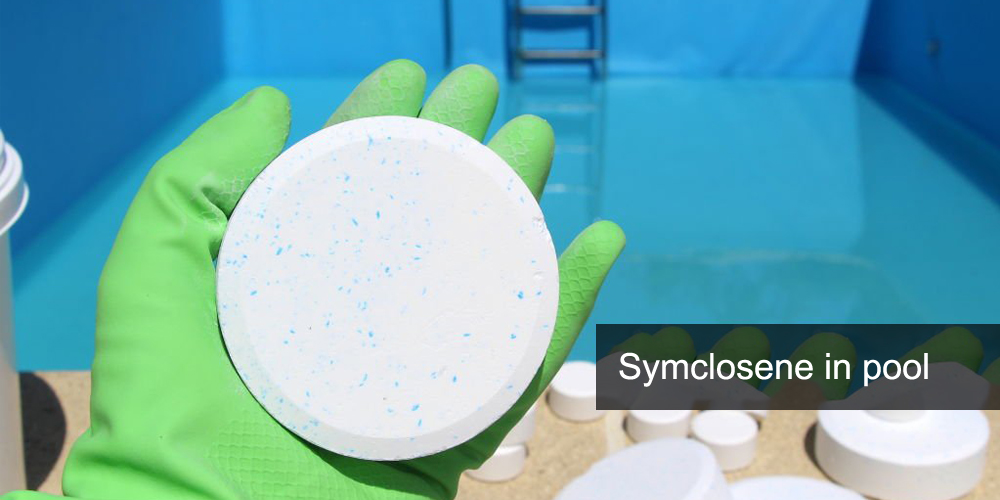Symclosene is an efficient and stable swimming pool disinfectant, which is widely used in water disinfection, especially swimming pool disinfection. With its unique chemical structure and excellent bactericidal performance, it has become the first choice for many swimming pool disinfectants. This article will give you a detailed introduction to the working principle, use and precautions of Symclosene. Prepare for your full and effective understanding and use of swimming pool disinfectants.
The working principle of Symclosene
Symclosene, which is what we often call trichloroisocyanuric acid (TCCA). It is an efficient and stable chlorine-based disinfectant. Symclosene will slowly release hypochlorous acid in water. Hypochlorous acid is a strong oxidant with extremely strong bactericidal and disinfecting effects. It can destroy the cell structure of bacteria, viruses, and algae by oxidizing proteins and enzymes, making them inactive. At the same time, hypochlorous acid can also oxidize organic matter, prevent algae growth, and keep the water clear.
And TCCA contains cyanuric acid, which can slow down the consumption of effective chlorine, especially in outdoor swimming pools with strong sunlight, which can effectively reduce the loss of chlorine and improve the durability and economy of disinfection.
Common uses of Symclosene
Symclosene is often available in tablet, powder, or granule form. In pool maintenance, it often comes in tablet form. The specific use method varies depending on the size of the pool, the amount of water, and the frequency of use. The following are common uses:
Daily maintenance
Put Symclosene tablets in floats or feeders and let them dissolve slowly. Automatically control the amount of Symclosene added according to the pool water quality.
Water quality testing and adjustment
Before using Symclosene, the pH value and residual chlorine concentration of the pool water should be tested first. The ideal pH range is 7.2-7.8, and the residual chlorine concentration is recommended to be maintained at 1-3ppm. If necessary, it can be used in conjunction with pH adjusters and other pool chemicals.
Regular replenishment
As chlorine is consumed, Symclosene should be replenished in time according to the test results to maintain the chlorine content in the water.
Precautions for Symclosene
pH control: Symclosene has the best bactericidal effect when the pH value is 7.2-7.8. If the pH value is too high or too low, it will affect the sterilization effect and even produce harmful substances.
Avoid overdose: Excessive use may cause excessive chlorine content in the water, which may irritate human skin and eyes, so it is necessary to add it strictly according to the recommended dosage.
Compatibility with other chemicals: Symclosene may produce harmful gases when mixed with certain chemicals, so the product instructions should be carefully read before use.
Keep the water circulating: After adding Symclosene, ensure that the swimming pool circulation system operates normally, so that the chemicals are fully dissolved and distributed in the water, and avoid excessive local chlorine concentration.
Storage method of Symclosene
Correct storage method can extend the service life of Symclosene and ensure its safety and effectiveness:
Store in a dry and ventilated place
Symclosene is hygroscopic and should be stored in a cool, dry, well-ventilated place away from direct sunlight.
Avoid high temperature
High temperature may cause Symclosene to decompose or spontaneously combust, so the storage environment temperature should not be too high.
Keep away from flammables and other chemicals
Symclosene is a strong oxidant and should be kept away from flammables and reducing chemicals to prevent unexpected reactions.
Sealed storage
After each use, the packaging bag or container should be sealed to prevent moisture absorption or contamination.
Keep away from children and pets
When storing, ensure that children and pets cannot reach to avoid accidental ingestion or misuse.
Advantages and disadvantages compared with other disinfection methods
| Disinfectant | Advantages | Disadvantages |
| Symclosene | High-efficiency sterilization, good stability, easy to use, safe storage | Overuse can increase cyanuric acid levels in water, affecting sterilization effectiveness. |
| Sodium Hypochlorite | Low cost, fast sterilization | Poor stability, easily decomposed, strong irritation, difficult to transport and store. |
| Liquid Chlorine | Effective sterilization, wide application range | High risk, improper handling may cause accidents, difficult to transport and store. |
| Ozone | Rapid sterilization, no secondary pollution | High equipment investment, high operational costs. |
When using Symclosene or other pool chemicals, always read the product instructions carefully and follow them exactly as directed. If in doubt, consult a professional.
Post time: Nov-19-2024

